Make raw milk yogurt at home using an Instant Pot, a dehydrator, a proofing box, or an oven. All the benefits of raw milk are preserved in this easy, cold-start yogurt recipe.
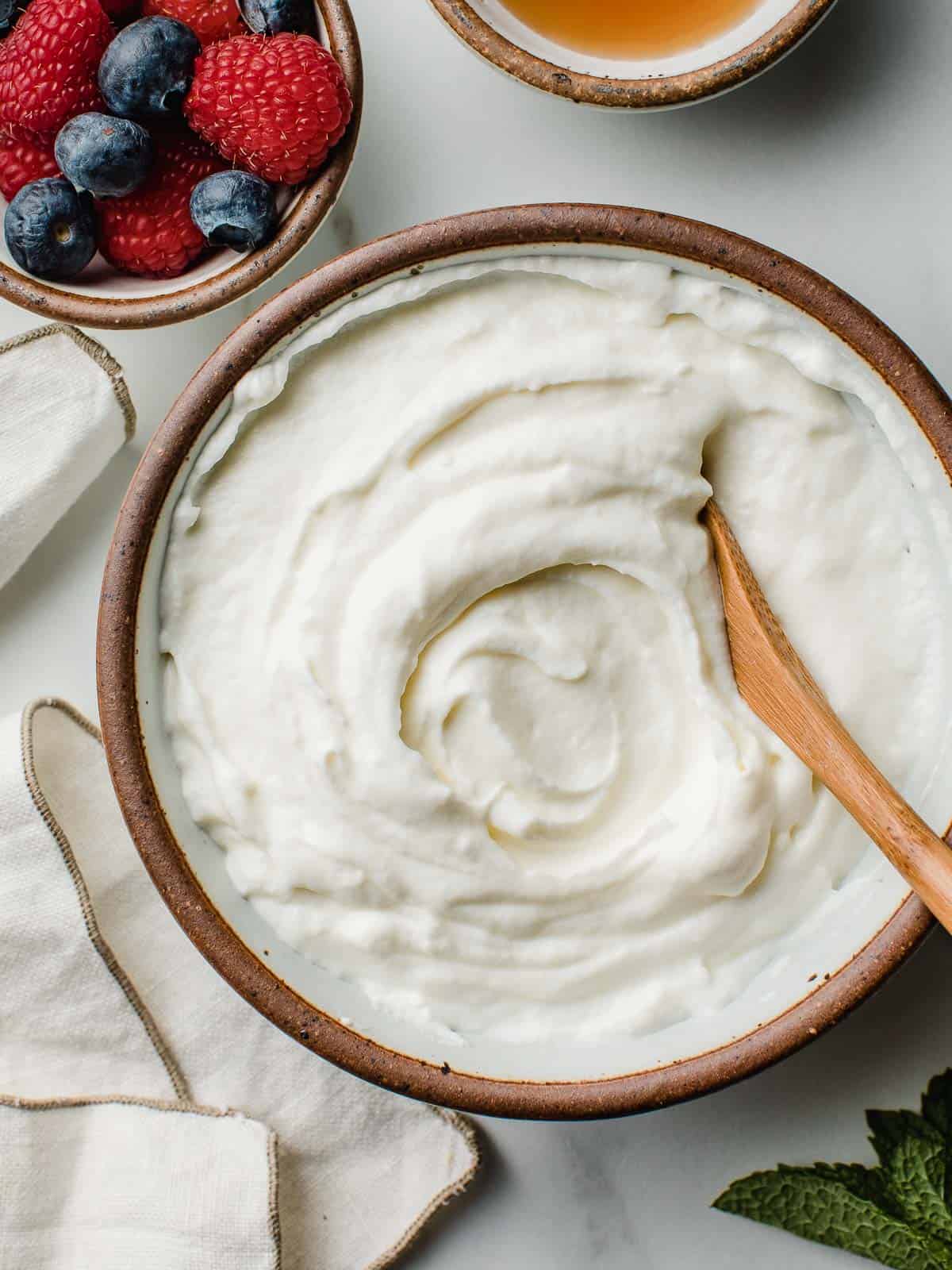
There are many ways to make yogurt at home without a yogurt maker.
All you need is milk, a small amount of yogurt containing active live cultures like lactobacillus, and a way to keep it at a warm temperature for 8-24 hours in order for it to culture and thicken.
If you have an Instant Pot, mix the milk and yogurt inside of the liner, press a button, and let it do its job. 8-24 hours later you’ve got yogurt!
A dough-proofing box, a dehydrator, or an oven that can be set at a steady temperature of 110°F, for up to 24 hours, work great too.
The only difference is that you’ll need glass mason jars to hold the yogurt as it cultures. Once the yogurt is done, simply transfer the jars straight to the fridge.
I use fresh raw milk to make homemade yogurt because of its health benefits. Raw milk hasn’t been heated or treated with any chemicals.
I am fortunate enough to pick up milk that was milked from the cow the same morning. It doesn’t get any fresher than that!
If you don’t have access to raw milk, feel free to use store-bought pasteurized milk, organic milk, goat’s milk, or sheep’s milk. The culturing process will help to restore some of the enzymes lost through the pasteurization process.
Enjoy raw milk yogurt plain or add it to a blender with fresh fruit, honey, or maple syrup for a probiotic smoothie.
Other homemade pantry recipes: homemade butter / sourdough starter / pesto / bone broth / vanilla extract / pizza sauce
Jump to:
What is raw milk yogurt?
Raw milk yogurt is made with milk that has not been pasteurized. It has a thin, pourable consistency that is similar to kefir.
The flavor and texture are determined by the fat content of the milk and the starter culture used to innoculate the yogurt.
Although the yogurt is thin, it can be strained into a thick Greek-style yogurt or even raw yogurt cheese, similar to cream cheese.
Raw milk yogurt is full of vitamins, minerals, good bacteria, beneficial enzymes, and several strains of probiotics which help to maintain well-balanced gut health.
These numerous bioactive components kill pathogens in the milk, prevent pathogen absorption through the intestinal wall, and help to strengthen the immune system.
It literally has its own built-in safety system which makes raw milk yogurt safe to eat.
When milk is pasteurized, these qualities are destroyed. Pasteurization also denatures the proteins in milk making them "sticky".
Is raw milk yogurt good for digestion?
Just like when you sprout a grain or seed, the fermentation of raw milk produces many beneficial qualities.
The process of fermentation breaks down the casein in the milk which is one of the hardest proteins for humans to digest.
It also helps to predigest lactose, the sugar in milk that so many people are sensitive to.
Lactase is the enzyme that helps digest lactose and makes it possible to tolerate fermented milk products. Lactase turns lactose into lactic acid.
The more lactic acid in the yogurt, the tangier it will taste. The fermentation process breaks down 30-40% of the lactose content.
Other enzymes are restored to help with the absorption of calcium and other minerals the body needs.
When you eat yogurt on a regular basis, you are providing your digestive tract with beneficial bacteria and lactic acid.
They are wonderful at keeping pathogens in check and aid in the fullest digestion possible when consumed alone or with other foods.
Yogurt fermented for 24 hours is acceptable for anyone on a gut healing protocol such as the GAPS diet.
Ingredients needed
- One gallon of raw milk (or organic pasteurized milk, goat's milk, or sheep's milk)
- 1 cup plain yogurt (preferably organic)
Plain yogurt, referred to as a yogurt starter culture, is the source of the bacteria that inoculates the milk.
Some people find it more convenient to use a yogurt starter culture (affiliate link) for consistent results but I've never had issues using organic store-bought yogurt.
NOTE: After you have your first batch of yogurt, always save one cup of yogurt to inoculate the next batch. If you forget, simply use organic plain yogurt from the store.
Equipment needed
(Amazon affiliate links) - Check out my favorite kitchen essentials.
- 6-quart Instant Pot or larger, dough-proofing box, dehydrator, OR an oven that can be set to 110°F (43.3°C)
- whisk
- measuring cup
- half gallon mason jars
- quart-sized mason jars
- mesh strainer
- large bowl
- tea towel
Can I make this recipe with pasteurized milk?
Making yogurt with raw milk will produce the highest level of enzymes within the yogurt, but if raw milk is not available, be assured that you will still benefit by using pasteurized milk when making this cold-start homemade yogurt.
Fermenting, or culturing milk can help to restore the enzymes, such as lactase, that are lost during the pasteurization process of yogurt.
Step-by-step instructions
Yogurt is made by heating the milk with a yogurt culture and then left to sit at a warm temperature to help the bacteria grow and cultivate.
Raw milk yogurt needs to ferment for a minimum of 8 hours, up to 24 hours, at 110°F (43.3°C).
The longer the yogurt is allowed to culture, the more lactose is reduced and the thicker it will be. (I find that the 20-hour mark is my sweet spot.)
"The temperature must be 108°F to 112°F for yogurt bacteria to grow properly. Too high a temperature inactivates bacteria; too low a temperature prohibits growth." - Washington State University Extension
Instant Pot Instructions without a yogurt button
- Clean the stainless steel insert of the Instant Pot, the lid, and the sealing ring with hot soapy water before starting.
- Pour one gallon of milk into the liner along with 1 cup of full-fat plain yogurt. Use a whisk to disperse the yogurt and cream throughout the milk.
- Place the lid on the Instant Pot and press the SOUS VIDE button. Set the timer to a minimum of 8 hours up to 24 hours. Set the temperature to 110°F (43.3°C).
- Transfer the finished yogurt to glass containers and place them in the fridge for 24 hours to set.
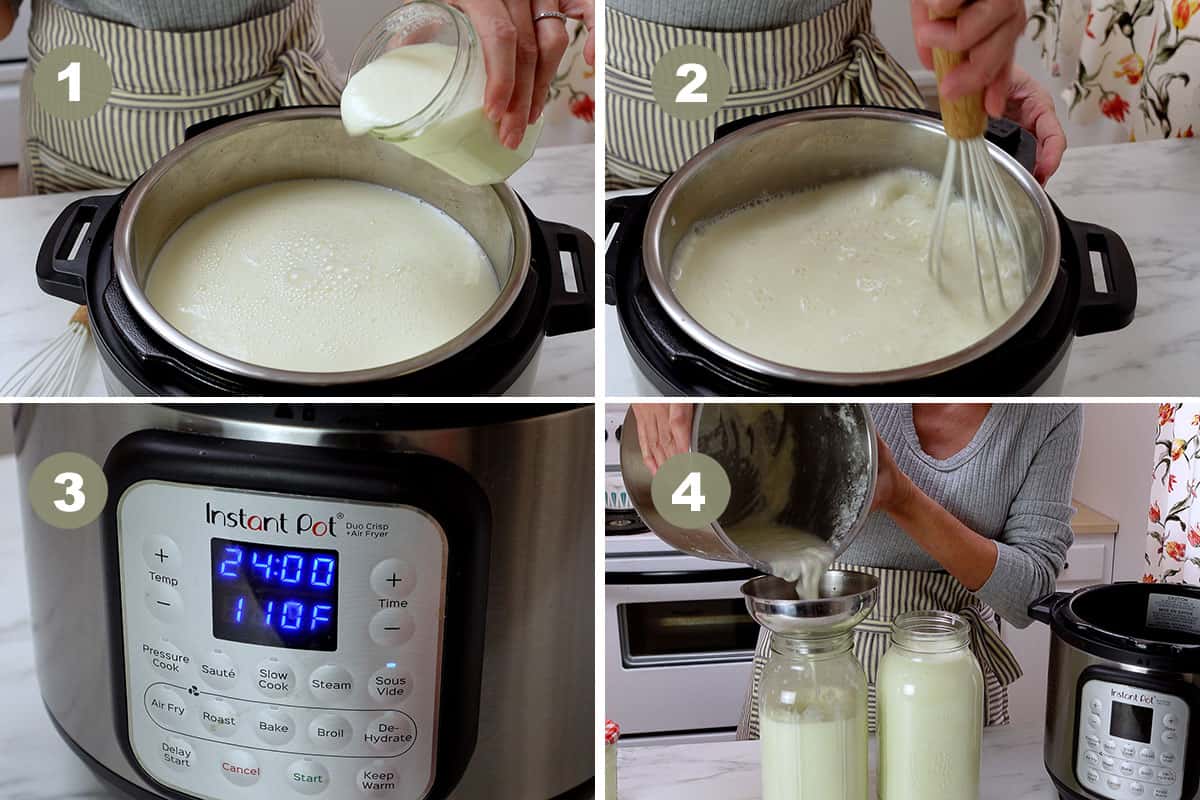
The YOGURT setting on an Instant Pot has two modes, the BOIL mode, and the INCUBATE mode. Press the YOGURT button until you see a timer to activate the INCUBATE mode. Set the timer to 24 hours.
Dehydrator, proofing box, oven instructions
- Whisk together one cup of yogurt and 2 cups of milk in a bowl.
- Split the mixture evenly into 4 quart-sized mason jars and top the jars with the remaining milk.
- Screw lids onto each of the jars and shake.
- Place the jars into the chosen equipment.
- Set the temperature to 110°F (43.3·C) and allow the milk to culture for a minimum of 8 hours up to 24 hours.
- Transfer the jars to the fridge for 24 hours for the yogurt to set.
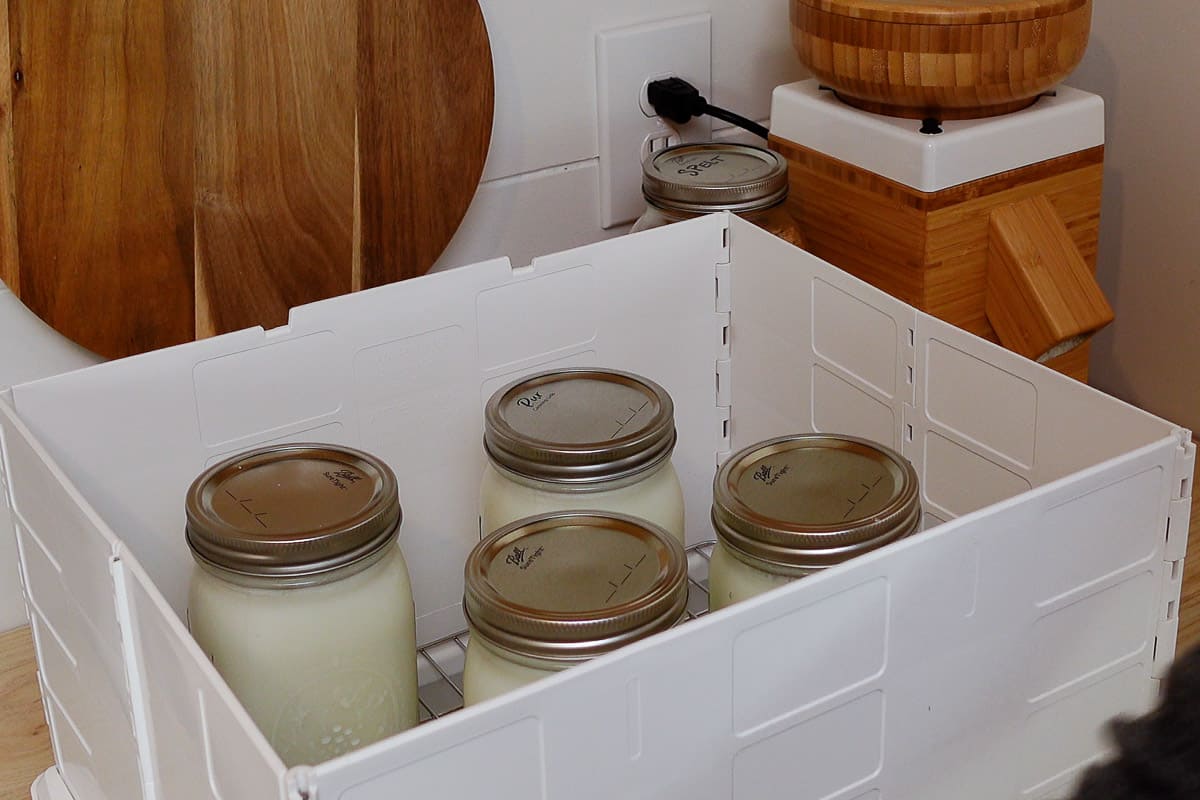
Raw milk yogurt should have a pleasant smell and taste for a minimum of 12-14 days or even longer when kept in the refrigerator.
How to make raw greek yogurt
To make raw greek yogurt, you will need the strain the whey. The longer the yogurt is strained, the thicker the greek yogurt will be.
I find it's easiest to strain a quart, up to a half gallon of yogurt at a time.
- Place a fine mesh strainer over a bowl. Line the strainer with a clean tea towel or several layers of cheesecloth.
- Pour a portion of the yogurt into the towel-lined strainer and cover it with a lid or a large plate.
- Transfer the bowl to the fridge for several hours or until the yogurt is at the desired thickness.
- Scoop the thickened greek yogurt into a small container with a lid and store it in the refrigerator.
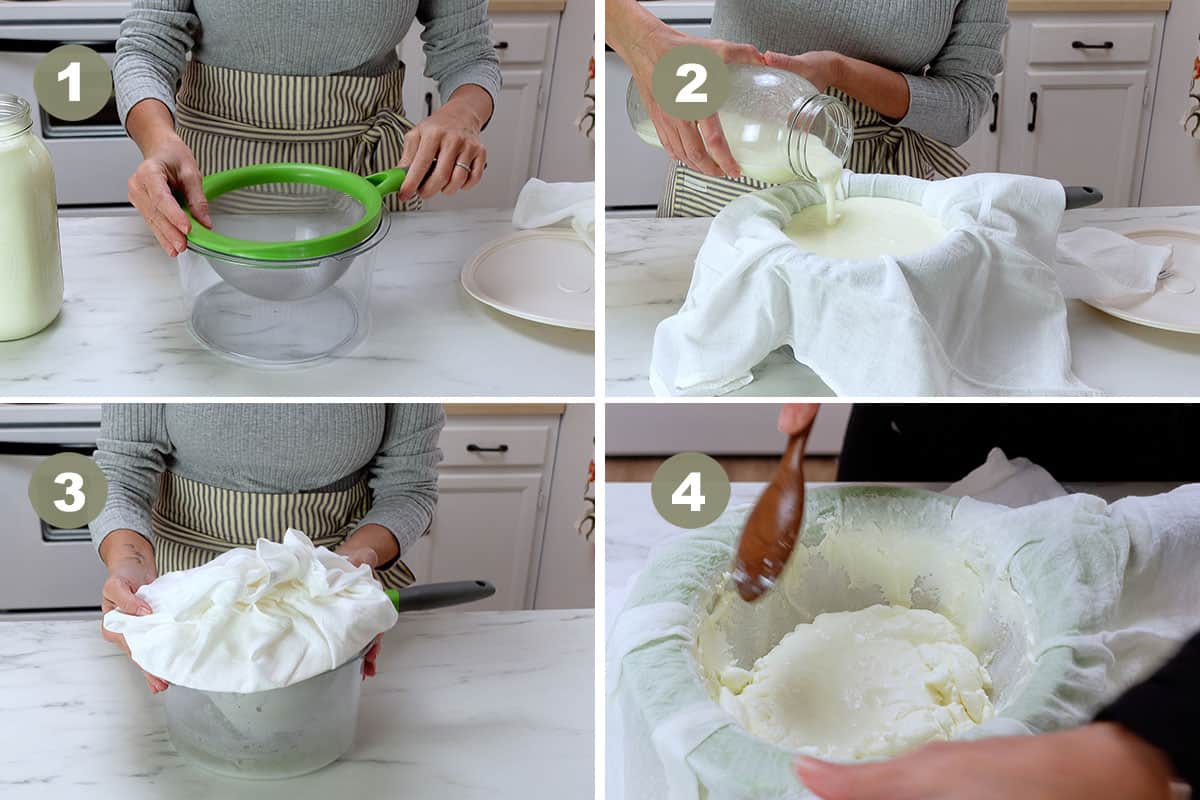
Transfer the liquid, or whey in the bottom of the bowl to a separate container with a lid and store it in the fridge to use with other recipes.
Best uses for whey
A handy and beneficial byproduct of yogurt is sweet whey. It is the liquid that separates from the yogurt.
Whey is full of minerals and just one tablespoon of water can help in digestion with a meal.
Whey from cultured milk is invaluable when making fermented vegetables such as:
- sauerkraut
- soaking oats
- soaking legumes
- fermented beverages
- fermenting chicken feed
- replace the water in recipes
- smoothies
- water plants
Common questions
Visit the website RawMilkFinder.com and search for a farmer in your area that participates in herdshares. You can also find information about the raw milk laws in your state by visiting ProCon.org.
Pasteurization of milk was introduced at the time of large-scale, industrialized dairy farming to make sure the milk stayed safe for the public to consume. Pasteurization lowers the risks of milk being contaminated by harmful bacteria and pathogens. As more and more people moved away from rural areas and into large cities, the demand for pasteurized milk grew.
Small dairy farmers that participate in herdshares typically have a very small number of dairy cows making it easy to keep sanitary milking conditions. They follow strict dairy best practices to ensure the milk does not become contaminated.
Raw milk yogurt is made through the process of lacto-fermentation. Lacto-fermentation breaks down the milk proteins and milk sugars with lactic acid-producing bacteria. Once these bacteria have produced enough lactic acid, the milk is preserved from becoming spoiled.
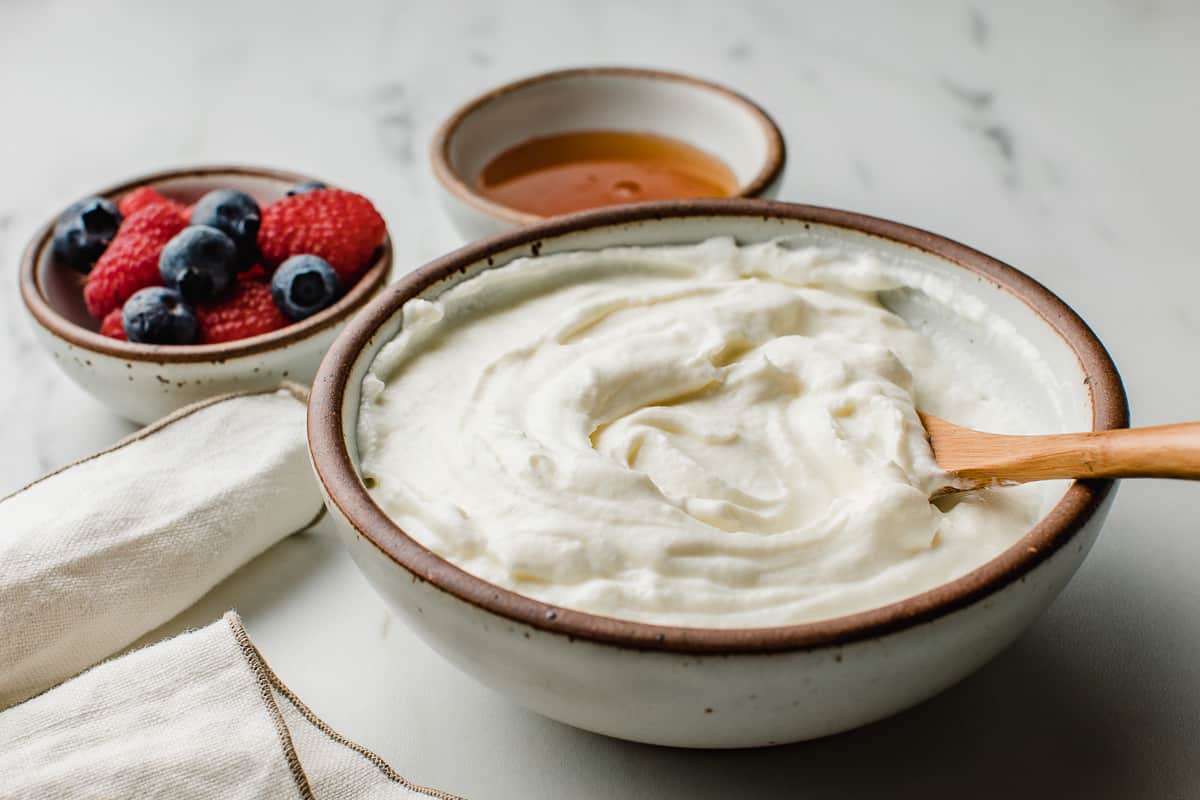
Do you like this recipe? Make sure to subscribe to our newsletter and we'll send you fresh recipes, valuable troubleshooting advice, useful tips, and other information we believe will be helpful to you!
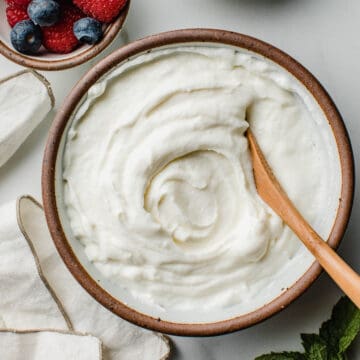
Raw Milk Yogurt
INGREDIENTS
- 1 gallon raw milk
- 1 cup full-fat plain yogurt (preferably organic)
INSTRUCTIONS
Instant Pot instructions
- Clean the stainless steel insert of the Instant Pot, the lid, and the sealing ring with hot soapy water before starting.
- Pour one gallon of milk into the liner along with 1 cup of full-fat plain yogurt. Use a whisk to disperse the yogurt and cream throughout the milk. Place the lid on the Instant Pot and press the SOUS VIDE button. Set the timer to 24 hours and the temperature to 110°F (43.3°C). (OR, press the YOGURT button twice and set the timer to 24 hours.)
- When the time is up, remove the lid and give the yogurt a stir. Transfer 1 cup to a small jar to inoculate the next batch. Transfer the remaining yogurt to glass containers and place it in the fridge for 24 hours to set.
Dehydrator, proofing box, oven instructions
- Whisk together one cup of yogurt and 2 cups of milk in a bowl. Split the mixture evenly into jars and top the jars with the remaining milk. Screw lids onto each of the jars and shake. Place the jars into the chosen equipment. Set the temperature to 110°F (43.3·C) and allow the milk to culture for a minimum of 8 hours up to 24 hours. Transfer the jars to the fridge for 24 hours for the yogurt to set.
How to make raw greek yogurt
- Place a fine mesh strainer over a large bowl. Line the strainer with a clean, thin tea towel or several layers of cheesecloth. Pour a portion of the yogurt into the towel-lined strainer and cover it with a lid or a large plate. Transfer the bowl to the fridge for several hours or until the yogurt is at the desired thickness.
- Scoop the yogurt into a small container with a lid and store it in the refrigerator. Transfer the whey located in the bottom of the bowl to a separate container with a lid and store it in the fridge.



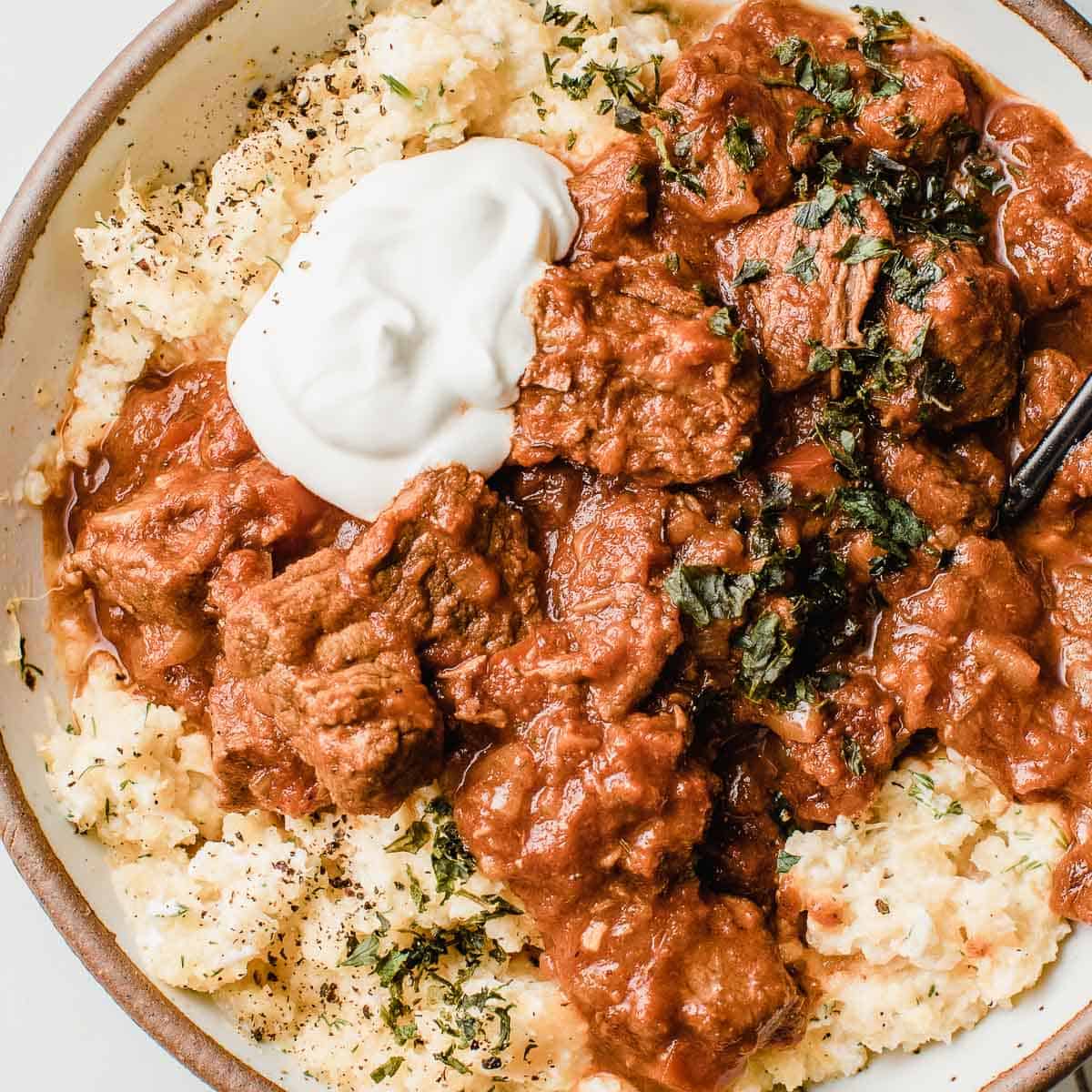
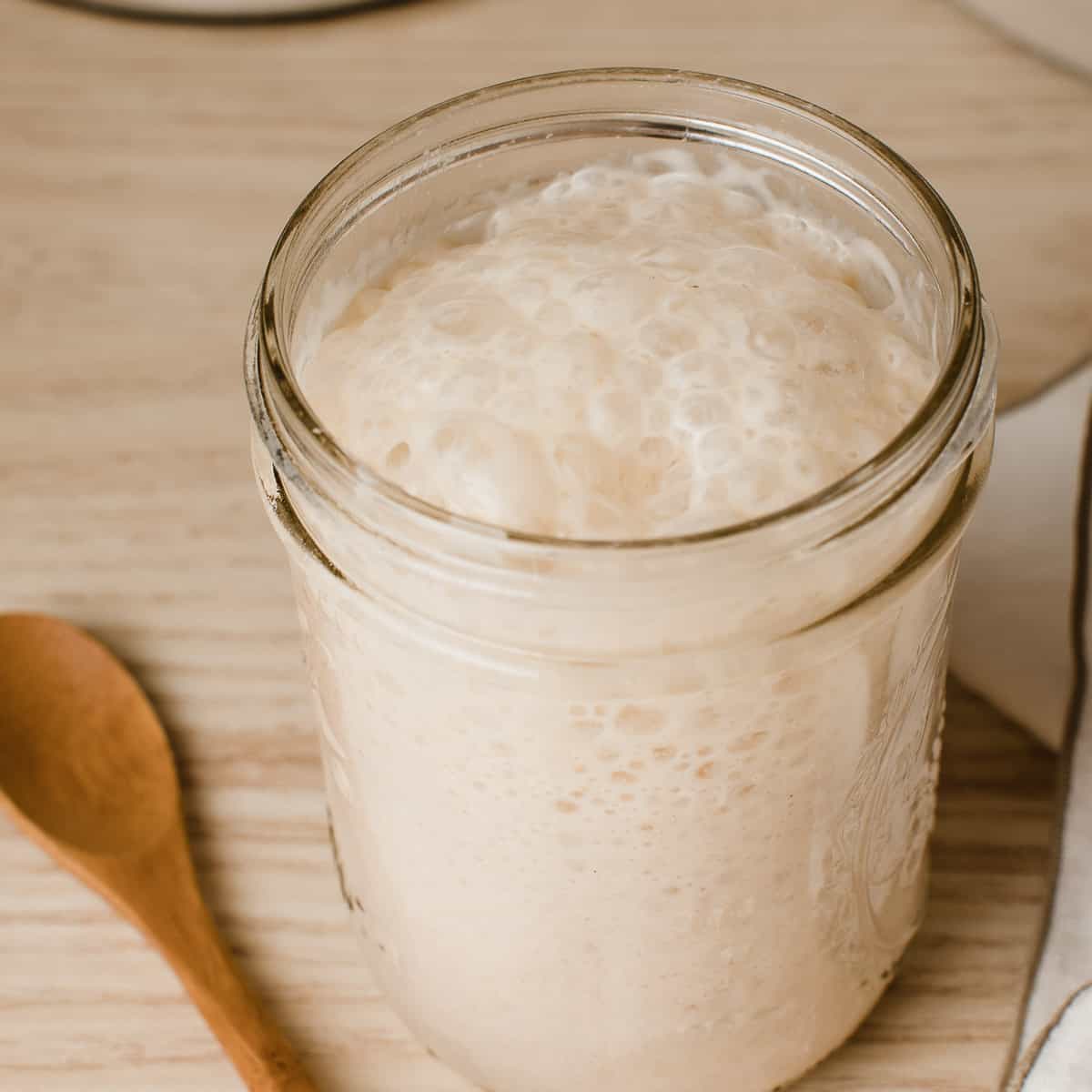
Michelle says
If I’m going to strain the yogurt to make Greek yogurt, do I still transfer to the fridge after the 20 hours in the Instant Pot and let cool for an additional 24 hours? Or can I stain right away and then transfer to fridge?
Amy says
I strain my yogurt right away!
Heather says
Why are the beginning amounts so drastically different btwn using the instapot vs. using the dehydrator?
1c. starter yogurt for a whole gallon milk
vs
1c. starter yogurt for only 2c. milk?
I really want to try the one gallon recipe inside of my large Excalibur dehydrator but I don't want to be turned away by a gigantic failure. Is there a specific reason why it wouldn't work?
Amy says
Hi Heather, the reason I say to mix the yogurt with 2 cups of milk in a separate bowl is so that you can distribute the yogurt more evenly. After you mix those together, divide them amongst your jars and then top them off with the remaining milk. That way the milk to yogurt starter ratio is correct in each jar.
Tierney says
Thank you for this recipe! I will say that I once tried watering a houseplant with strained whey. It was a disaster of bugs (probably gnats) and mold growth. But that is not a reflection of this recipe or your wonderful website!
Holly says
If I'm only doing 1/2 gallon, do I need to cut time as well?
Amy says
The yogurt needs at least 8 hours up to 24 hours regardless of the amount being made.
Janell says
Does anyone know how long this recipe will be good in the fridge? I would like to write a "good by" date on the yogurts.
Amy says
Hi Janell, raw milk yogurt should last up to 14 days in the fridge.
Tiffany Langford says
I want to try this! What’s the best way to flavor it?
Amy says
Hi Tiffany! I flavor my yogurt after it's made by adding fruit and other toppings. I've seen other people add vanilla extract and sweetened condensed milk to homemade yogurt but I've never tried it myself.
Armen says
I've been using a similar recipe with my Instant Pot, but after the Boil stage, I cool the milk down to 118 deg and then add the starter (I usually use Nancy's or other store bought when starting over, looking for products without added pectin or other thickeners.) I then put it back in the IP for 8 1/2 hrs. My yogurt frequently comes out grainy. I'll try your method and compare. Any thoughts on why the grainy texture?
Amy says
I think it has something to do with heating the milk to high. That happened to me when I used to bring the milk up to 185°F and let it cool back down. I really like the cold start method much better.
JB says
Any thoughts on why, after about 8 hours, I see the milk and whey separating in the jar?
Amy says
If the yogurt is starting to separate after 8 hours, I would go ahead and put it in the fridge instead of letting it culture longer. Did you use a yogurt starter from the store?
Sandra says
I have tried several methods of making yogurt. Fortunately for me, I have my own goats, so a supply of raw, fresh milk is easy when they are lactating.
My issue is texture!! No matter what method I've tried, I still come up with weird textures - runny, goopy, sloppy..... and the flavor isn't ever anything like real yogurt.
Any suggestions that don't involve adding gelatin or other additives?
Amy says
This cold start method has really worked well for me, but I always strain the yogurt to get the thickness I am looking for. Once it's strained and I stir it, the texture is always smooth. Have you tried the Instant Pot method? It's my personal preference.
Marinna Nowlin says
I use an immersion blender because my husband prefers it to be smoother and within seconds it’s completely smooth!
Mary says
Excited to try this method.
WGI says
How would I go about just making yogurt with half a gallon of raw milk?
Amy says
Use half gallon of milk along with 1/2 cup of plain yogurt.